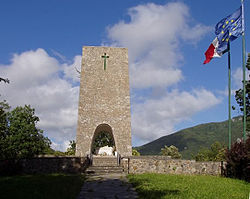Tuscany
Tuscany (Italian: [Toscana] Error: {{Lang}}: text has italic markup (help)) is a region in the center of Italy. It has an area of 22,990 square kilometres (8,880 sq mi) and a population of about 3.6 million people (in 2004). The capital is Florence.
|
Toscana | |
|---|---|
 | |
| Country | Italy |
| Capital | Florence |
| Government | |
| • President | Claudio Martini (Democratic Party) |
| Area | |
| • Total | 22,990 km2 (8,880 sq mi) |
| Population (2007-12-31) | |
| • Total | 3,677,048 |
| • Density | 159.94/km2 (414.25/sq mi) |
| Time zone | UTC+1 (CET) |
| • Summer (DST) | UTC+2 (CEST) |
| GDP/ Nominal | €99.1 billion (2006) |
| NUTS Region | ITC |
| Website | www.regione.toscana.it |
Tuscany is known for its landscapes and its artistic legacy. Six Tuscan localities have been made UNESCO protected sites: the historical center of Florence (1982), the historical center of Siena (1995), the square of the Cathedral of Pisa (1987), the historical center of San Gimignano (1990), the historical center of Pienza (1996) and the Val d'Orcia (2004).
Geography
Tuscany borders Emilia-Romagna to the north, Liguria to the north-west, Tyrrhenian Sea to the west, Umbria and Marche to the east, and Lazio to the south-east. The territory is two thirds hilly and one fourth mountainous. The rest is made up of the plains that form the valley of the Arno River.
Economy
Tuscany is known for its wines (the most famous of which are Chianti, Morellino di Scansano, Vino Nobile di Montepulciano, and Brunello di Montalcino) and has 120 protected regions (nature reserves). Other agricultural products include cattle (particularly the famous "Fiorentina" steak) and the production of olive oil, principally in Lucca.
The subsoil in Tuscany is rich in mineral resources. There are iron ore, copper, mercury and lignite mines, the famous soffioni (fumarole) at Larderello, and the vast marble mines in Versilia. Although its share is falling, agriculture is still important. In the region's inland areas, cereals, potatoes, olives and grapes are grown. The swamplands, which used to be marshy, now produce vegetables, rice, tobacco, beets and sunflowers.[1]
Tourism is important to the so-called "Cities of Art" (Florence, Arezzo, Lucca, Pisa, Siena, San Gimignano), as well as on the coast and in the isles (Elba).
Demographics
In the 1980s and 1990s the region attracted an intense of immigrants, in particular from China and Northern Africa. There is also a significant community of British and Americans. As of 2006, the Italian national institute of statistics ISTAT estimated that 215,490 foreign-born immigrants live in Tuscany, about 5.9% of the people in Tuscany.
Towns of Tuscany with a population of 50,000 or more:
| Comune | Population (2006 est.) |
|---|---|
| Florence | 366,901 |
| Prato | 183,823 |
| Livorno | 160,534 |
| Arezzo | 95,229 |
| Pisa | 87,737 |
| Pistoia | 85,947 |
| Lucca | 84,422 |
| Grosseto | 76,330 |
| Massa | 69,399 |
| Carrara | 65,125 |
| Viareggio | 63,389 |
| Sienna | 54,147 |
| Arezzo | 100,455 |
Provinces
Important points for industry in Tuscany
|
|
Famous people born in Tuscany
Tuscany Media
Cinerary urns of the Villanovan culture
The Chimera of Arezzo, Etruscan bronze, 400 BC
Battle of Montaperti, 1260
Hanging and burning of Girolamo Savonarola in Piazza della Signoria in Florence 1498 — painting depicting Renaissance Florence
Map of the Grand Duchy of Tuscany
Memorial to the victims of the Sant'Anna di Stazzema massacre, in which 560 locals were murdered by Nazi Germans and Italian Fascists in 1944
A painting from the Sienese School by Pietro Lorenzetti
Related pages
Other websites
- Official Site of Regions Tuscany (Italian site) Archived 2010-10-04 at the Wayback Machine









